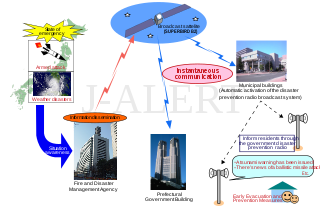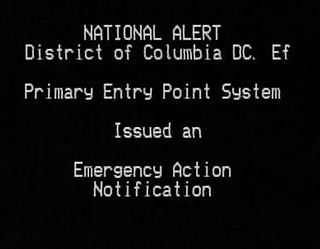Related Research Articles

The Emergency Alert System (EAS) is a national warning system in the United States designed to allow authorized officials to broadcast emergency alerts and warning messages to the public via cable, satellite and broadcast television and both AM, FM and satellite radio. Informally, Emergency Alert System is sometimes conflated with its mobile phone counterpart Wireless Emergency Alerts (WEA), a different but related system. However, both the EAS and WEA, among other systems, are coordinated under the Integrated Public Alert and Warning System (IPAWS). The EAS, and more broadly IPAWS, allows federal, state, and local authorities to efficiently broadcast emergency alert and warning messages across multiple channels. The EAS became operational on January 1, 1997, after being approved by the Federal Communications Commission (FCC) in November 1994, replacing the Emergency Broadcast System (EBS), and largely supplanted Local Access Alert systems, though Local Access Alert systems are still used from time to time. Its main improvement over the EBS, and perhaps its most distinctive feature, is its application of a digitally encoded audio signal known as Specific Area Message Encoding (SAME), which is responsible for the characteristic "screeching" or "chirping" sounds at the start and end of each message. The first signal is the "header" which encodes, among other information, the alert type and locations, or the specific area that should receive the message. The last short burst marks the end-of-message. These signals are read by specialized encoder-decoder equipment. This design allows for automated station-to-station relay of alerts to only the area the alert was intended for.

A tornado warning is a public warning that is issued by weather forecasting agencies to an area in the direct path of a tornado, or a thunderstorm capable of producing one, and advises individuals in that area to take cover. Modern weather surveillance technology such as Doppler weather radar can detect rotation in a thunderstorm, allowing for early warning before a tornado develops. They are also commonly issued based on reported visual sighting of a tornado, funnel cloud, or wall cloud, typically from weather spotters or the public, but also law enforcement or local emergency management. When radar is unavailable or insufficient, such ground truth is crucial. In particular, a tornado can develop in a gap of radar coverage, of which there are several known in the United States.
Specific Area Message Encoding (SAME) is a protocol used for framing and classification of broadcasting emergency warning messages. It was developed by the United States National Weather Service for use on its NOAA Weather Radio (NWR) network, and was later adopted by the Federal Communications Commission for the Emergency Alert System, then subsequently by Environment Canada for use on its Weatheradio Canada service. It is also used to set off receivers in Mexico City and surrounding areas as part of the Mexican Seismic Alert System (SASMEX).

NOAA Weather Radio (NWR), also known as NOAA Weather Radio All Hazards, is an automated 24-hour network of VHF FM weather radio stations in the United States that broadcast weather information directly from a nearby National Weather Service office. The routine programming cycle includes local or regional weather forecasts, synopsis, climate summaries or zone/lake/coastal waters forecasts. During severe conditions the cycle is shortened into: hazardous weather outlooks, short-term forecasts, special weather statements or tropical weather summaries. It occasionally broadcasts other non-weather related events such as national security statements, natural disaster information, environmental and public safety statements, civil emergencies, fires, evacuation orders, and other hazards sourced from the Federal Communications Commission's (FCC) Emergency Alert System. NOAA Weather Radio uses automated broadcast technology that allows for the recycling of segments featured in one broadcast cycle into another and more regular updating of segments to each of the transmitters. It also speeds up the warning transmitting process.
The Common Alerting Protocol (CAP) is an XML-based data format for exchanging public warnings and emergencies between alerting technologies. CAP allows a warning message to be consistently disseminated simultaneously over many warning systems to many applications, such as Google Public Alerts and Cell Broadcast. CAP increases warning effectiveness and simplifies the task of activating a warning for responsible officials.

An emergency population warning is a method where by local, regional, or national authorities can contact members of the public to warn them of an impending emergency. These warnings may be necessary for a number of reasons, including:
A fire warning is a warning issued through the Emergency Alert System (EAS) in the United States by civil authorities to inform the public of major, uncontrolled fires threatening populated areas and/or major roadways. A red flag warning will generally precede any fire activity by at least one to two days. A fire warning will generally include information on the location and movement of the fire, evacuation instructions, and shelter locations.
A flood warning is closely linked to the task of flood forecasting. The distinction between the two is that the outcome of flood forecasting is a set of forecast time-profiles of channel flows or river levels at various locations, while "flood warning" is the task of making use of these forecasts to make decisions about whether warnings of floods should be issued to the general public or whether previous warnings should be rescinded or retracted.

J-Alert is the early warning system used in Japan. J-Alert was launched in February 2007. The system is designed to quickly inform the public of threats and emergencies such as earthquakes, severe weather, and other dangers. The system was developed in the hope that early warnings would speed up evacuation times and help coordinate emergency response.
The HEARO Local Alert Receiver was an emergency management tool to relay and display informational text messages in English, Spanish, French and German using RDS technology. It notified local residents in the event of an emergency within a matter of seconds. HEARO carried NOAA weather warnings and other public safety text alerts, using FM radio infrastructure with a 60-hour battery life, HEARO was able to work when electricity, telephone and Internet were unavailable. viaRadio Corporation of Melbourne, Florida manufactured and distributed HEARO receivers.
The Mount Rainier Volcano Lahar Warning System consists of two separate components, operating in tandem: Acoustic Flow Monitors (AFM) and the All Hazard Alert Broadcast (AHAB) sirens. The AFM system was developed by the United States Geological Survey (USGS) in 1998 and is now maintained by Pierce County Emergency Management. The purpose of the warning system is to assist in the evacuation of residents in the river valleys around Mount Rainier, a volcano in Washington, in the event of a lahar. Pierce County works in partnership with the USGS, the Pacific Northwest Seismic Network (PNSN), Washington Military Department's Emergency Management Division, and South Sound 9-1-1 to monitor and operate the system.

Wireless Emergency Alerts, is an alerting network in the United States designed to disseminate emergency alerts to mobile devices such as cell phones and pagers. Organizations are able to disseminate and coordinate emergency alerts and warning messages through WEA and other public systems by means of the Integrated Public Alert and Warning System.

A National Emergency Message, formerly known until 2022 as an Emergency Action Notification, is the national activation of the Emergency Alert System (EAS) used to alert the residents of the United States of a national or global emergency such as a nuclear war or any other mass casualty situation. This alert can only be activated by the president of the United States or a designated representative thereof, such as the vice president. The Emergency Broadcast System (EBS) also carried the Emergency Action Notification. Except for the 2011 national test, which utilized the Emergency Action Notification alert type, no president has ever issued a National Emergency Message.
A river flood warning is issued by the National Weather Service of the United States when forecast points with formal river gaging sites and established flood stages along rivers, where flooding has already been forecast, is imminent or occurring. The National Weather Service defines river flooding as "the inundation of normally dry areas as a result of increased water levels in an established water course."

A law enforcement warning is a warning issued through the Emergency Alert System (EAS) in the United States to warn the public of criminal events that pose a threat to public safety. These include jailbreaks, riots, and bomb explosions. An authorized law enforcement agency may blockade roads, waterways, or facilities, evacuate or deny access to affected areas, and arrest violators or suspicious persons. The warning is usually issued by a law enforcement agency and is relayed by the National Weather Service.
A civil emergency message is a warning issued through the Emergency Alert System (EAS) in the United States to warn the public of a significant in-progress or imminent threat or danger to public safety. It is typically issued by a local or state authority and is relayed by the National Weather Service. The warning is a higher priority than a local area emergency (LAE), but it's less specific than a civil danger warning (CDW). For example, the warning could be used to describe an alert issued by the National Terrorism Advisory System.
Local area emergency is an advisory issued by local authorities through the Emergency Alert System (EAS) in the United States to notify the public of an event that does not pose a significant threat to public safety and/or property by itself, but could escalate, contribute to other more serious events, or disrupt critical public safety services. Instructions, other than public protective actions, may be provided. Examples include: a disruption in water, electric or natural gas service, road closures due to excessive snowfall, or a potential terrorist threat where the public is asked to remain alert.
A civil danger warning is a warning issued through the Emergency Alert System (EAS) in the United States to warn the public of an event that presents danger to a significant civilian population. It is typically issued by a local or state authority and is relayed by the National Weather Service. The warning usually mentions a specific hazard such as contaminated water supply, active shooting, unexpected weather alert such as causing roads to be extremely dangerous, major accident, or an imminent or in-progress military or terrorist attack. It may also provide instructions for protective action such as to evacuate, shelter-in-place, boil water or seek medical treatment. The warning has a higher priority than a local area emergency (LAE), as well as a Civil Emergency Message (CEM).
On February 1, 2005, the Emergency Alert System was activated in portions of Connecticut calling for the immediate evacuation of the entire state. The activation was in error. Later studies showed that residents did not evacuate, and that the most common response was to 'change the channel' or seek other confirmation.

On the morning of January 13, 2018, an alert was accidentally issued via the Emergency Alert System and Wireless Emergency Alert System over television, radio, and cellular networks in the U.S. state of Hawaii, instructing citizens to seek shelter due to an incoming ballistic missile. It concluded with "This is not a drill". The message was sent at 8:08 a.m. local time. The state had not authorized civil defense outdoor warning sirens.
References
- ↑ "- YouTube". YouTube .
- https://www.weather.gov/help-map
- https://www.weather.gov/lub/nonweathercemdescriptions
- https://www.youtube.com/watch?v=QBN4nAyGk5A